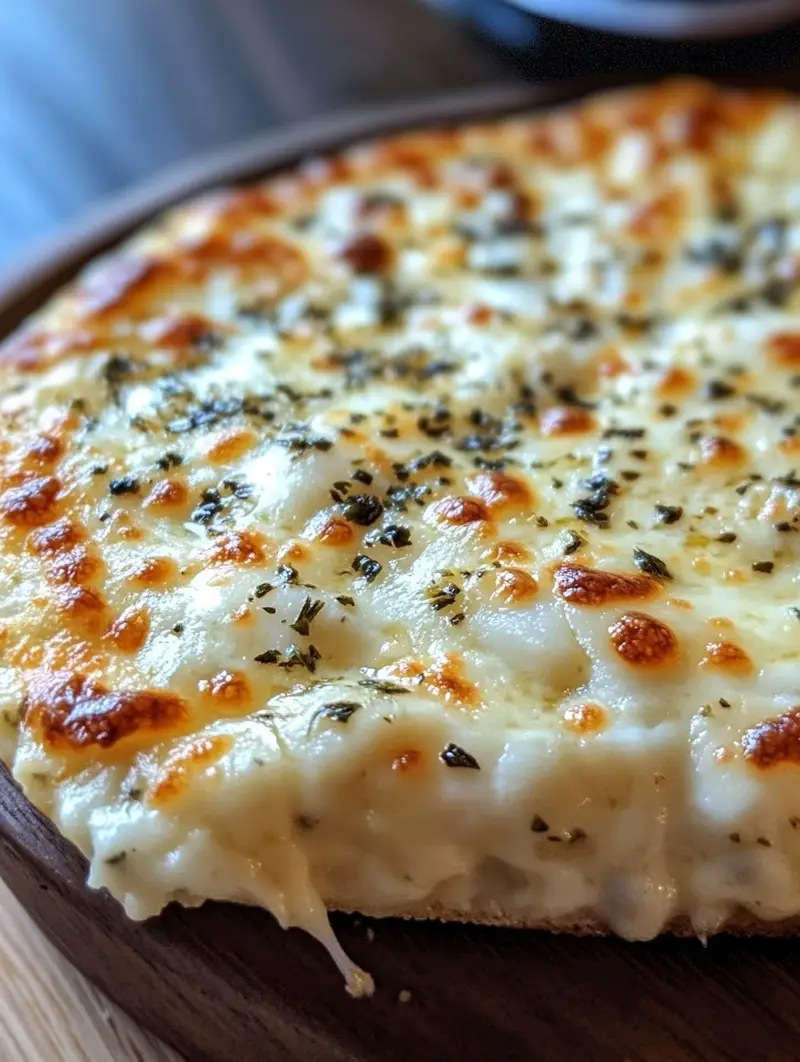I have always loved creating pizza from scratch, but one of the elements that truly elevates a homemade pizza is the sauce. Over time, I discovered that a creamy, flavorful white garlic pizza sauce can completely transform a simple dough and toppings into something extraordinary. The first time I made this sauce, the aroma of garlic sizzling gently in butter and olive oil filled my kitchen, and I knew this would become my go-to pizza base. It’s smooth, rich, and has just the right balance of garlic and herbs, making every slice irresistible.
You will love this recipe because it is both decadent and simple. Unlike traditional tomato sauces, this white garlic pizza sauce has a velvety texture that complements a wide variety of toppings. Whether you’re adding turkey bacon, chicken ham, or just fresh vegetables, the sauce enhances every bite without overpowering the other flavors. Its creamy consistency ensures that every pizza slice stays perfectly moist while still allowing the crust to crisp up beautifully.
This sauce is incredibly versatile. Not only can it be used on pizzas, but it also works wonderfully as a dipping sauce for breadsticks, a drizzle over roasted vegetables, or even as a base for creamy pasta dishes. Its mild yet savory flavor makes it suitable for all ages, and it pairs equally well with both classic and gourmet toppings.
The ingredients for this recipe are simple and affordable, yet they come together to create a luxurious taste:
-
4 tablespoons unsalted butter
-
4 cloves garlic, minced
-
2 tablespoons all-purpose flour
-
1 ½ cups whole milk, warm
-
½ teaspoon salt
-
¼ teaspoon black pepper
-
¼ teaspoon ground nutmeg (optional)
-
½ cup grated Parmesan cheese
-
1 teaspoon dried Italian herbs (or a mix of oregano, basil, and thyme)
Every ingredient contributes to the perfect creamy, garlicky flavor, and you likely already have most of them in your kitchen. Making this sauce at home is not only budget-friendly but also allows you to control the freshness and quality of each component, which ultimately makes your pizza taste far better than store-bought alternatives.
Making this white garlic pizza sauce from scratch is easier than it sounds, and it only takes a few simple steps to create a creamy, flavorful base that will elevate any pizza. I always start by preparing all the ingredients in advance, which makes the process quick, smooth, and stress-free.
Step-by-Step Instructions for Preparation:
-
Melt the butter: In a medium saucepan, melt 4 tablespoons of unsalted butter over medium heat. Make sure it melts evenly without browning.
-
Sauté the garlic: Add 4 minced garlic cloves to the melted butter and cook for about 1–2 minutes, stirring constantly. The garlic should be fragrant but not browned, as burnt garlic will make the sauce bitter.
-
Make the roux: Sprinkle 2 tablespoons of all-purpose flour over the garlic and butter mixture. Stir continuously for 1–2 minutes to create a smooth paste, which will help thicken the sauce.
-
Add the milk gradually: Slowly pour 1 ½ cups of warm whole milk into the roux, whisking constantly to prevent lumps. Continue whisking until the mixture is smooth and begins to thicken.
-
Season the sauce: Add ½ teaspoon salt, ¼ teaspoon black pepper, and ¼ teaspoon ground nutmeg (optional). Stir well to incorporate the seasonings evenly.
-
Incorporate the cheese: Gradually add ½ cup of grated Parmesan cheese, stirring until it melts completely into the sauce. This creates a rich, creamy texture with a slightly nutty flavor.
-
Add herbs: Stir in 1 teaspoon of dried Italian herbs or a mix of oregano, basil, and thyme. This adds depth and a subtle aromatic note that pairs perfectly with pizza toppings.
-
Simmer gently: Reduce the heat to low and let the sauce simmer for 2–3 minutes, stirring occasionally. Make sure it does not boil, as this could cause the milk to curdle.
-
Adjust consistency if needed: If the sauce becomes too thick, add a little more warm milk, one tablespoon at a time, until you reach your desired consistency.
This white garlic pizza sauce is quick and easy, taking less than 20 minutes from start to finish. It’s also highly customizable—you can adjust the amount of garlic, cheese, or herbs to match your personal taste. For a more indulgent version, try adding a teaspoon of cream or a pinch of smoked paprika for subtle depth.
Many people love this sauce because it complements a wide range of pizza toppings. It pairs beautifully with turkey bacon, chicken ham, beef, fresh vegetables, or even simple cheese-only pizzas. The creamy texture ensures that every bite is smooth and flavorful, making it a favorite at family dinners, parties, or casual pizza nights.
This recipe is also versatile for other dishes. Use it as a pasta sauce, a base for creamy casseroles, or even as a dip for garlic breadsticks. Its richness and flavor make it a universal sauce that works in many recipes beyond pizza.
PrintBest White Garlic Pizza Sauce Recipe for Homemade Pizza
This creamy white garlic pizza sauce is the perfect base for homemade pizzas, adding rich flavor and smooth texture to every bite. It’s simple to make, versatile, and elevates both classic and gourmet pizza toppings.
- Prep Time: 5
- Cook Time: 15
- Total Time: 20 minutes
- Yield: ½
Ingredients
- 4 tablespoons unsalted butter
- 4 cloves garlic, minced
- 2 tablespoons all-purpose flour
- 1 ½ cups whole milk, warm
- ½ teaspoon salt
- ¼ teaspoon black pepper
- ¼ teaspoon ground nutmeg (optional)
- ½ cup grated Parmesan cheese
- 1 teaspoon dried Italian herbs (or a mix of oregano, basil, and thyme)
Instructions
- In a medium saucepan, melt the butter over medium heat without letting it brown.
- Add the minced garlic and sauté for 1–2 minutes until fragrant, stirring constantly.
- Sprinkle the flour over the butter and garlic mixture and stir continuously for 1–2 minutes to form a smooth roux.
- Gradually whisk in the warm milk, ensuring no lumps form. Continue whisking until the sauce thickens.
- Season with salt, black pepper, and optional nutmeg, stirring well to incorporate.
- Add the grated Parmesan cheese gradually, stirring until completely melted.
- Stir in dried Italian herbs or a blend of oregano, basil, and thyme.
- Reduce heat to low and simmer for 2–3 minutes, stirring occasionally. Do not boil.
- If the sauce is too thick, add warm milk one tablespoon at a time until desired consistency is reached.
- Remove from heat and use immediately as a pizza base, pasta sauce, or dip.
Notes
Adjust garlic and herbs to suit your taste.
For a creamier version, add a teaspoon of cream at the end.
The sauce pairs well with turkey bacon, chicken ham, beef, vegetables, or cheese-only pizzas.
FAQs
1. Can I make this sauce ahead of time?
Yes, you can prepare the sauce up to 2 days in advance. Store it in an airtight container in the refrigerator and reheat gently over low heat, adding a splash of milk if needed to restore its creamy consistency.
2. Can I use a different type of cheese?
Absolutely. While Parmesan gives a classic nutty flavor, you can also use Pecorino Romano or a mild mozzarella for a creamier, milder taste.
3. Is it possible to make this sauce dairy-free?
Yes, you can substitute the butter with plant-based margarine and use a dairy-free milk alternative such as oat milk or almond milk. Nutritional yeast can replace Parmesan for a cheesy flavor.
4. How can I make the sauce thicker or thinner?
To thicken, cook it a little longer over low heat. To thin it, add warm milk gradually until you reach your desired consistency.
5. Can I freeze this sauce?
Yes, the sauce freezes well for up to 2 months. Thaw it in the refrigerator overnight and reheat gently, whisking to restore smoothness.
6. Can I use fresh herbs instead of dried?
Definitely. Fresh herbs like basil, oregano, or thyme can be added at the end of cooking for a brighter, fresher flavor. Use about 1 tablespoon of chopped fresh herbs in place of 1 teaspoon dried.


